The Golf Courses Around Lake Merced
by Matt Cohn
November, 2007
PLEASE NOTE: Within this essay are links to sixteen aerial views on Google Maps and Microsoft Virtual Earth. Thank you for taking the time to view them as you read. Three things to remember:
1) You can expand Google Maps images to a full-screen view by clicking the small arrow to the left of the image.
2) You can do the same thing to Virtual Earth images by dragging the divider all the way to edge of the window; also, click on ‘Aerial’, ‘Bird’s Eye’, or different compass points to change your view.
3) Move around, zoom in, and pan out to get a better look at all the courses.
Thank you also to Jon Spaulding and Mike Benham for the use of their ground-level images.
Matt Cohn
Many places in the world have nice golf courses. But only a few can claim a group of world-class courses in such close proximity that it seems as though that small corner of the world exists solely for the purpose of playing the game. One gets the sense not simply of a collection of individual clubs, but rather one great space for golf shared by a handful of grand and fortunate layouts.
Perhaps four spots in the world are consensus picks to meet this high standard of grand layouts sharing superlative spaces: Pebble Beach (Pebble Beach, Cypress Point, Spyglass, Monterey Peninsula (2), Spanish Bay, Poppy Hills); Southampton (National Golf Links, Shinnecock, Sebonack, Southampton); Westchester (Winged Foot (2), Westchester (2), Quaker Ridge, Fenway, Wykagyl) and Melbourne’s Sandbelt (Royal Melbourne (2), Kingston Heath, Metropolitan, Commonwealth, Yarra Yarra, Huntingdale, Victoria). In addition, London, Pinehurst, Bandon, and a couple of spots in Scotland are near shoo-ins. Other places offer excellent courses in close proximity – Scottsdale and the Mornington Peninsula, for example – but perhaps need one more stellar course to rival the other locations mentioned above.
Pebble Beach, CA…
…and Westchester, NY are two of the world’s greatest places for golf.
But at least one more locale deserves to be a part of the discussion. This small area has five golf courses:
Course 1 is a mainstay in the U.S. Open rotation.
Course 2 will host several top-tier PGA Tour events over the next decade.
Course 3 hosted a USGA championship recently enough to claim Tiger Woods as a competitor.
Course 4 is ranked in the country’s top 20 courses.
Course 5 co-hosted a recent US Amateur Championship.
These five courses are found within a total of just two-and-a-half square miles. In fact, two short but noteworthy nine-hole courses produce a total of 108 holes in that space.
Where is this place? The title of this piece gives away the answer to an otherwise challenging question. Chicago would be a thoughtful guess, with Chicago Golf Club, Cog Hill, Medinah, and Olympia Fields – except that none of those courses are within ten miles of each other!
The answer, of course, is that the five courses described above are clustered around Lake Merced, straddling the border between San Francisco and Daly City. They are:
Course 1: The Olympic Club’s Lake Course.
Course 2: Harding Park Golf Course.
Course 3: Lake Merced Golf Club, which hosted the US Junior Amateur in 1990.
Course 4: San Francisco Golf Club, ranked #15 in the U.S. by Golf Magazine.
Course 5: The Olympic Club’s Ocean Course.
The golf courses around Lake Merced.
The border between San Francisco and Daly City runs through the southern portion of the Olympic Club’s property. And no, the street is not named after that John Daly!
It’s a group which has contributed to a great deal of golf history, led by the Olympic Club which has hosted eight USGA championships. San Francisco Golf Club no longer hosts tournaments, but Olympic, Lake Merced, and Harding Park are currently in the midst of a remarkable run of important events: the 2004 US Junior (Olympic), 2005 WGC-American Express Championship (Harding), 2006 Pacific Coast Amateur and 2007 US Amateur (both at Olympic), 2009 NCAA West Regional and California State Amateur (both at Lake Merced), 2009 Presidents Cup, 2010 and 2011 Charles Schwab Cup (all at Harding), 2011 California State Amateur and 2012 US Open (both at Olympic), and two more significant PGA Tour events at Harding Park before 2019.
It is one of the most notable concentrations of top-quality golf anywhere in the world. However, the purpose of this piece is not to convince the reader of this opinion, nor to rank the courses relative to each other, as there are certainly enough sources for that already.
Rather, this piece will attempt to compare the challenges offered, and the pleasures allowed, by each of these very distinct courses. It ought to be an interesting study, because amongst the hills and gigantic cypress trees that form the backdrop to golf in this part of the world exist five markedly different layouts.
Recently, this author has taken to using Google Earth and Microsoft Live maps to preview courses before rounds. A look from above is a good place to begin a comparison of these five courses, as the Lake, Ocean, Harding Park, Lake Merced, and SFGC look very different from that point of view.
Olympic Club captures our attention first, as the map shows a giant property near the cliffs of the Pacific. As we zoom in, we see the Ocean Course; its larger bunkers and wider corridors actually make it more interesting, from above, than the Lake Course. Remember that since this is an overhead view, we have no visual cues to the elevation changes.
Our first impression of the Ocean is likely one of confusion: Where does the routing go? (The secret is the path from the fifth green to sixth tee which includes a tunnel hidden under seventh fairway.) Why are there pot bunkers, and traditional bunkers, and modern bunkers, and even church pew bunkers? Why do so many holes look wide open, but a handful look so tightly hemmed in by trees? We’re interested, but thrown off, too.
The middle holes of the Ocean Course.
Note the tightly tree lined third fairway top-left; the church pew bunkers bottom-left; and the tunnel under the seventh fairway middle-right.
If we look across the service road, we find that the Lake Course offers a much more traditional appearance, but little of interest from above beyond the extraordinary number of doglegs. The steep slope that gives the course so much of its character is invisible from this viewpoint!
The Olympic Club’s Lake Course.
Next we jump across the water to Harding Park and it’s as though the scale of the map has suddenly changed. Harding’s fairways look huge; the greens look gigantic; the bunkers look big and full. As we glance back and forth between the Lake Course and Harding Park, we realize how tiny the Lake’s greens are; how narrow its fairways are; and, even from above, that it looks quirky compared to Harding. Harding looks like the perfect epitome of modern tournament course design, and now we’re not sure at all what to make of the Lake. After seeing the width of the corridors at Harding Park, we might worry whether we can hit the Lake Course’s fairways at all.
The Lake Course and Harding Park.
Notice the difference in scale of the greens and bunkers.
Eventually we scroll down from Harding Park to SFGC and find a bizarre looking place: lots of back-and-forth holes, incredibly wide fairways – they look like bubbles, not ribbons! – and enormous, cartoon-looking bunkers, some even larger than the greens they guard.
Finally, we move a few blocks south to Lake Merced Golf Club. Now it seems that the scale of the map has reverted. Lake Merced’s greens, fairways, and bunkers are half the size, maybe even less, compared to SFGC. In fact, Merced from above looks even tighter than Olympic – remember, we haven’t seen the slope of the Lake Course’s fairways yet. It’s also at Merced, not Olympic, that we really notice large trees crowding tight and twisting fairways.
San Francisco Golf Club (top) and Lake Merced Golf Club, only a few blocks apart.
Notice, again, the tremendous difference in scale; many of SFGC’s bunkers are larger than Lake Merced’s greens!
We have at least an idea of what to expect: we’ll need to drive it in the fairway at Lake Merced and the Lake Course; and we’ll get to take a rip at it at Harding Park and SFGC. We still don’t know what to think of the Ocean Course, so let’s explore that one from ground level first.
To its benefit or detriment, the essence of the Ocean Course is its variety – in terms of its looks, its architectural elements, and its playing requirements. One each nine, a few holes offer room to bash away, while others require quite careful placement. A handful of holes offer hilly lies, while others are flat. Most unusually, some greens offer a traditional rough-and-bunkers look, while the twelfth green is a dead ringer for Pinehurst #2, and the fourteenth hole offers a gigantic, tightly mown chipping area unlike anything else on either course. Even the conditions vary: the ‘top’ holes by the clubhouse are often windier and colder than the slightly sheltered ‘bottom’ holes by John Muir Drive.
A few examples of the variety found on the Ocean Course:
The traditional looking 3rd green…
…the modern-looking, wide open 2nd and 11th greens…
…the 5th, 7th, and 10th greens, surrounded by native grasses…
…and finally the exposed 17th green on the left and Pinehurst style 12th green on the right.
It’s a challenging course, no doubt, and it played just as tough as the Lake during the Pacific Coast Amateur in 2006. But it sure is hard to sum it up and pull out its defining characteristics. Perhaps its dominant attribute is a number of one-of-a-kind holes. Partly by terrain and partly by design, at least half of the Ocean’s holes are somehow quite different than any other hole the golfer has ever played, and often quite different from the other holes on the course, as well. That attribute creates a course that lacks some of the cohesiveness of its four sibling courses in the area; but also one whose challenges are comprehensive and admirably varied.
On the other side of the clubhouse, the Lake Course presents no difficulty in naming its defining characteristics: narrow fairways, hilly lies, tiny, sloping greens, and the aforementioned doglegs, which tend to arc rather than angle, and six of which are of the reverse-camber variety that decidedly shrink the effective width of the landing area. The steep slope of the land is apparent wherever one looks – from the clubhouse, from the early holes high on the hill, from the back nine looking up towards the clubhouse, and especially from Harding Park across the street, where one can see Olympic’s enormous clubhouse amongst the trees, near the top of a broad hill that appears steep even by San Francisco standards.
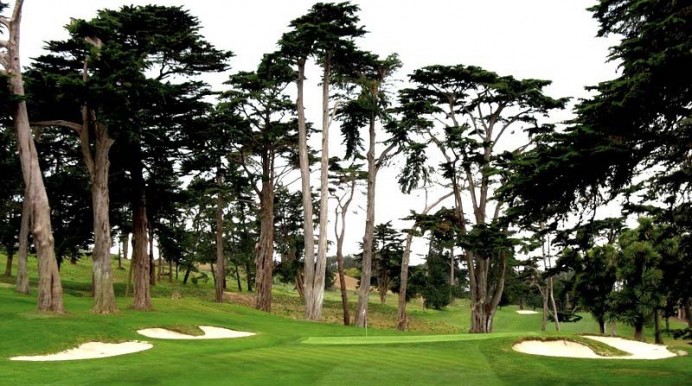
The green of the par four eleventh hole on the Lake Course.
A distinctive aspect of the Lake’s fame, charm, and challenge is its constant demand for uncomfortable shots, as the golfer finds out in the first few holes. On the second hole, for example, the tee shot is semi-blind, with the slope and wind both pushing the ball left towards a steep drop-off and nothing the help the golfer hit or hold the fairway. The ideal approach shot is a high fade – except that it’s played from a right-to-left slope, into a right-to-left quartering wind, and significantly uphill. Given the dramatically sloping green and deep bunkers, there is no good place to miss. And don’t forget the heavy air. It’s typical of the discomfort, or even awkwardness, which characterizes many of the Lake Course’s holes.
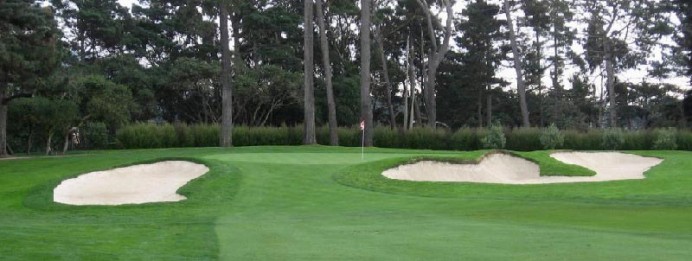
The sixteenth green on the Lake Course.
The course constantly demands shaped shots, starting on the first tee and continuing throughout the round. The Lake favors a right-hander’s fade, as holes one, five, nine, ten, twelve and thirteen simply cannot be played with a draw. On the other hand, with any sort of fade or slice, the tee shots on four, sixteen and seventeen are almost impossible to keep in the fairway under tournament conditions. When the constant sidehill lies in the fairways are considered as well, it’s difficult to think of another course which gives the golfer so few chances to play straight-ahead shots from flat lies. Finally, the Lake’s tiny, raised, and tilted greens offer few opportunities for improperly played shots to turn out well. Obviously, a deft short game is required as every golfer will miss a number of greens in regulation.
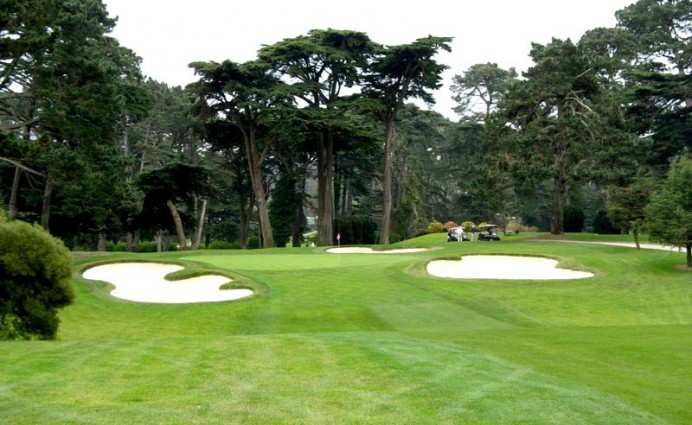
The approach to the small, sloping green of the par four sixth.
At a minimum then, the successful golfer at the Lake Course must excel at shaping the ball in every direction; at very accurate play from the tee; and also at playing precise approaches from not-so-standard situations.
Don’t pass up a chance to play Olympic’s par three Cliffs Course!
As we jump across the lake to Harding Park, we find that a very different description applies. Your driving range swing will work just fine, as only four fairways – the first, twelfth, fourteenth and fifteenth – offer even the suggestion of a non-level lie. As well, the playing corridors are much wider, and only one or two holes strongly suggest a particular shot shape. The greens are at least fifty percent larger than those of the Lake Course. Finally, while the Lake Course has its share of unusual features and local knowledge, Harding Park is ‘right there in front of you’ – and, for whatever the term means, it’s very fair as well.
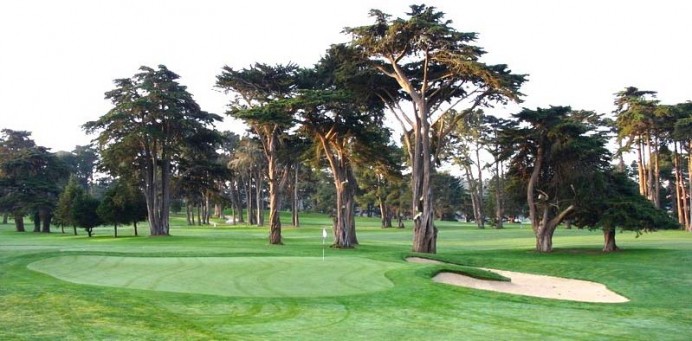
The first green at Harding Park. The background gives one a sense of the relatively flat land, at least by San Francisco standards.
Yet Harding Park remains a healthy challenge. It certainly held its own against a strong PGA Tour field in 2005, with a respectable winning score of 270 against the modified par of 280. How?
Under a tournament setup, Harding Park is about a hundred yards longer than the recently stretched Lake Course. But those hundred yards make a big difference as they give Harding Park a sizable collection of long par fours: five of them over 460 yards, compared to just two on the Lake Course. Length is a clear advantage at Harding. As evidence, consider the top two finishers in the 2005 WGC event: Tiger Woods and John Daly.
As well, despite the wide playing corridors, the fairways themselves have been maintained narrowly since the 2005 tournament. And the fact is that on several holes, it still doesn’t take much to become tangled in the tree line; yet because of the lengthy par-4’s, the driver comes out of the bag frequently. Of the five courses discussed here, Harding Park most rewards hitting the driver long, straight, and often. Consider that Tiger would likely hit twice as many drivers at Harding than at the Lake Course, despite that modest hundred-yard difference.
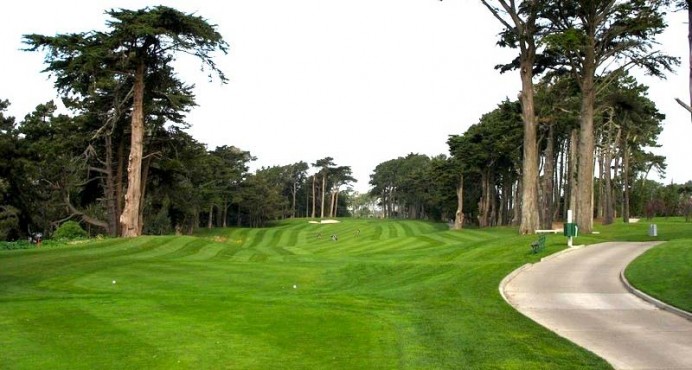
The long par four thirteenth hole at Harding, playing through a natural valley...

...and the long par four finisher.. On both holes, note the narrow fairway lines relative to the spacious corridors.
Harding offers all that we’d expect from a modern tournament course, including relatively tame greens to accommodate tournament green speeds; a clear advantage to players who can hit high, soaring iron shots; and framed, visually defined, carefully shaped holes that offer quite a contrast to the unsettling look of many holes on the Lake Course.
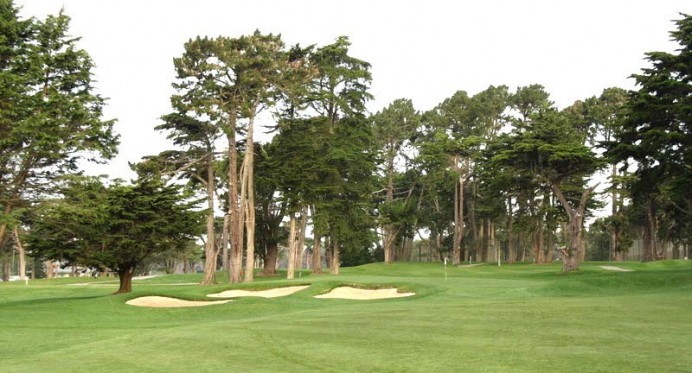
The green of Harding
From a highly representative example of a modern tournament course at Harding Park, we move a few blocks southeast to a course that is very much the opposite: unlike any other layout in the world. SFGC’s combination of a dramatic California landscape; expansive open spaces; and justifiably famous bunkering create a look that simply could not be confused with any other golf course. From an architectural perspective, those same characteristics perfectly facilitate strategic play. There’s one more requirement for strategic architecture, of course: interest in and around the greens. Here, SFGC stands apart with boldly contoured greens that are likely among the fastest and smoothest in the country on a day-to-day basis.
Clockwise, SFGC’s clubhouse, Eighteenth green, Tenth and ninth fairways, Third tee, second green, and first fairway.
The view from the clubhouse is captivating: a wide-open field of alluring golf holes that leave the golfer with no doubt that he is in for a special round. The first tee blends into the closely cut lawn around the clubhouse and opens up to the 70-yard-wide first fairway. From around the clubhouse, golfers can see parts of at least seven or eight holes. The open sightlines are incredibly appealing.
San Francisco’s par four sixth hole.
Once on the course, the golfer is relieved to have room to play, and learns quickly that most holes offer subtle risk/reward components. The 430 yard sixth, for example, teeters along the edge of a deep ravine (which is deeper than it looks in the overhead pictures, and which the golfer will soon enter with his tee shot on the famous ‘duel hole’, the seventh). The sixth fairway is fully fifty-five yards wide, but the left side offers a brilliant line of charm, a shorter route, a better angle…and the potential for disaster in the ravine, which would make the golfer feel doubly foolish about forsaking the safe line into an incredibly wide fairway.
Compared to its neighbors, SFGC actually offers plenty of birdie and par opportunities, particularly because its par fours are of manageable length (although two and seventeen are formidable holes) and also because the golfer is almost invariably in play after his tee shot.
The restored thirteenth through fifteenth and sixteenth holes at San Francisco Golf Club.
The greens, though, keep golfers decidedly honest, as a fifteen-foot birdie putt from the wrong side of the hole is not really a birdie putt at all. SFGC does not host tournaments, but a set of true tournament pins on those greens could be absolutely maddening and incredibly exacting. To be fair, the greens on any course change in character when speeds approach twelve or higher on the stimpmeter. But it’s the bold movement within SF’s greens, accentuated by that speed, that makes the surfaces so thought-provoking and makes all the strategizing back at the tee worthwhile.
Given the wide fairways, rolling greens, and eye-candy bunkers, one could mistake SFGC for a Mackenzie course – it was designed, of course, by A.W. Tillinghast. However, Mackenzie in fact did some work in the area, about three blocks away, at Lake Merced Golf Club.
None of Mackenzie’s work there remains as the course was completely rebuilt in the 1960’s. What exists now is a beautiful, very traditional-looking golf course which has few rivals in Northern California as a generous tournament host. In 2009, for example, Lake Merced will host the three-day NCAA West regional in May and the week-long California Amateur Championship just a month later.
Lake Merced Golf Club; from top-left, the seventh, sixth, first (green lower left), fourteenth, fifteenth and eighteenth fairways.
Our observations from the aerial pictures – that Lake Merced features lots of trees and narrow fairways – are correct. Also as we observed from above, the difference in scale from SFGC is drastic, especially given that the courses share similar terrain less than a third of a mile apart. The first fairway at Lake Merced is forty yards narrower than the first fairway at SFGC; Lake Merced’s first green is barely larger than the left fairway bunker at SFGC’s opening hole. The trees that line Lake Merced’s fairways are, on a few holes, confining, and they contribute to the more intimate scale of the course. On the first hole, for example, trees not only line the hole closely on both sides, but also interfere with a direct line to the left half of the fairway. In fact, five out of seven drives on Lake Merced’s front nine could easily hit lumber before the ball reaches the apex of its flight. As a result, the front nine’s demand for shaped tee shots nearly rivals what is required at the Lake Course.
Two other features of Lake Merced stand out relative to its neighbors. First are the greens. On the Lake Course, most greens are severely tilted, but a single arrow in a yardage book is adequate to diagram at least half of them. By comparison, Lake Merced’s greens have a very modern look, with narrow ridges, pronounced mounds, and strong tiers within the interior of the surfaces. As a result, various pin positions can completely change the character of a number of Lake Merced’s holes. On the long par three eighth hole for example, the large part of the green is essentially a bowl, but there’s also a high, saddled back-right tier over a deep bunker. Most pin placements will allow for a reasonable birdie putt; but with a back-right pin, less than 2,000 square feet of landing area will even allow us to get a birdie putt within a flagstick length of the hole. Comparable situations occur on a number of Lake Merced’s greens. For the tournament player, a well-marked yardage book and accurate iron play are both valuable assets.
A second standout feature at Lake Merced is the depth of the bunkers, particularly around the greens. Partly as a result of Rees Jones’ late 1990’s renovation, and partly because of a number of elevated greens, more than half of Lake Merced’s holes feature greenside bunkers deeper than head-high. Where deep bunkers are present, many of the green edges slope away from the lips, making a short-side bunker recovery even more improbable.
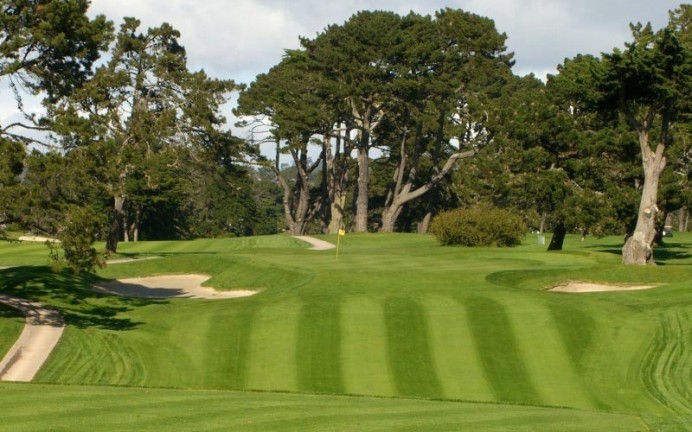
The par three twelfth at Lake Merced; note the bunker on the left side which is six to eight feet deep.
Obviously, between the tree lined fairways, complex greens, and deep bunkers, golf at Lake Merced is about remaining on the straight and narrow. It’s doesn’t feel like such a short golf course, but unbelievably the last par four over 400 yards comes at the seventh, and three of the four par fives are easily reachable by any good competitive player. Yet despite all of this, the course rating is still above 74. It would be difficult to stretch out Lake Merced beyond its current 6,863 yards as there just isn’t much room. Perhaps that’s a good thing. On the other hand, with a set of tees at 7,200 yards and a course rating around 76, Lake Merced would likely appear on everyone’s Top 100 lists and garner the sort of recognition that it probably deserves now.
The Olympic Club, San Francisco Golf Club, Lake Merced, and Harding Park have much in common. In particular, the cypress trees, hills, fog, and wind certainly give the courses a shared environment. A golfer is unlikely to forget which part of the world he’s in!
But truly these courses are notable for their diversity of design and playing experience. In that sense, the courses around Lake Merced are perhaps most like those of Melbourne’s Sandbelt: similar at first glance, but remarkably distinct upon further examination. While access ranges from municipal (Harding) to nearly impossible (SFGC), the golfer fortunate enough to play each of these five courses will have experienced a collection of golf courses that ranks among the finest in the world.
The End

